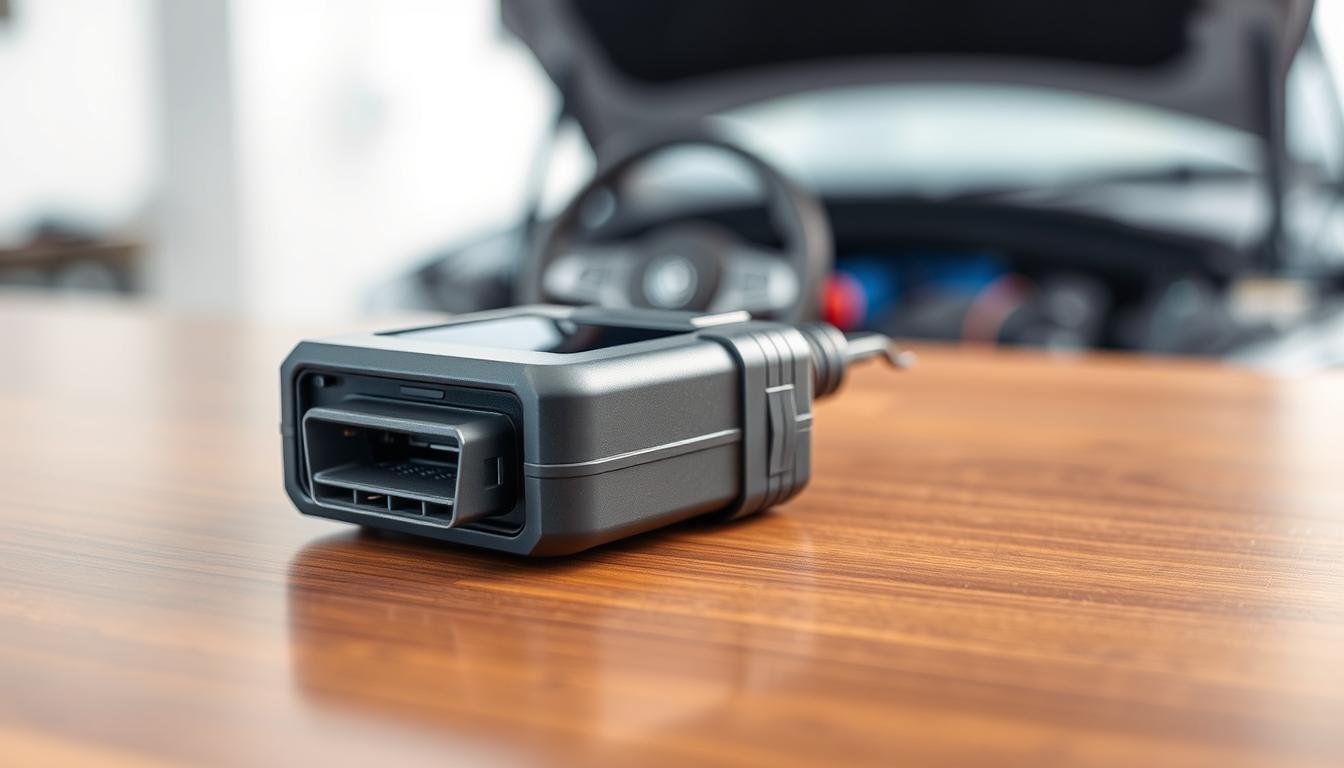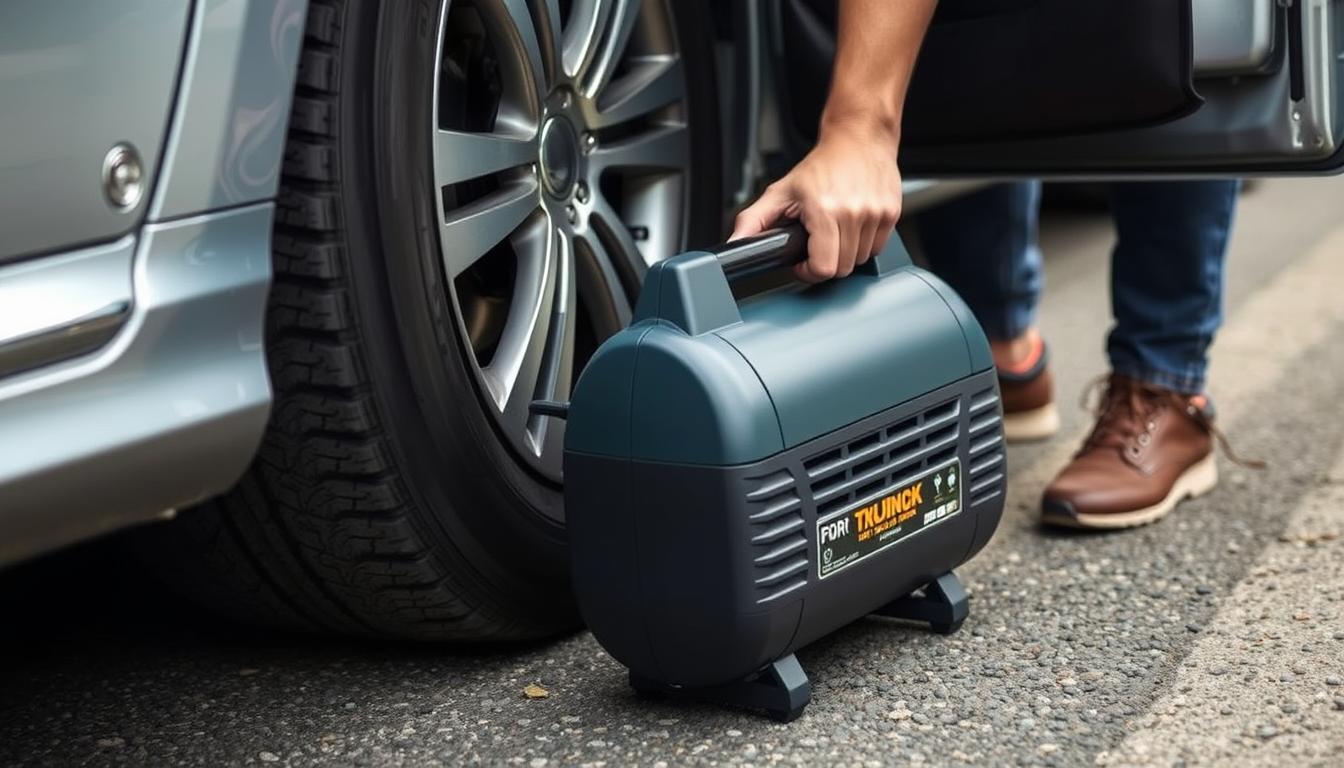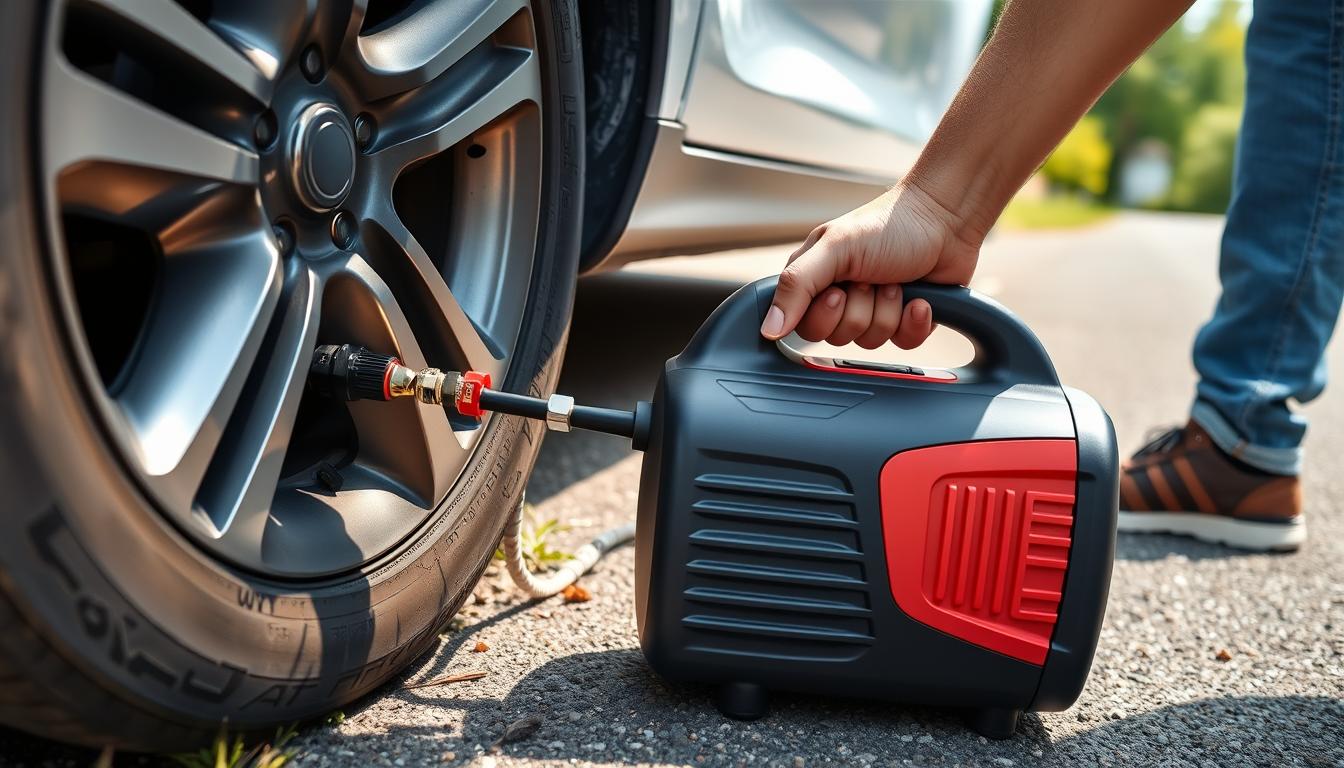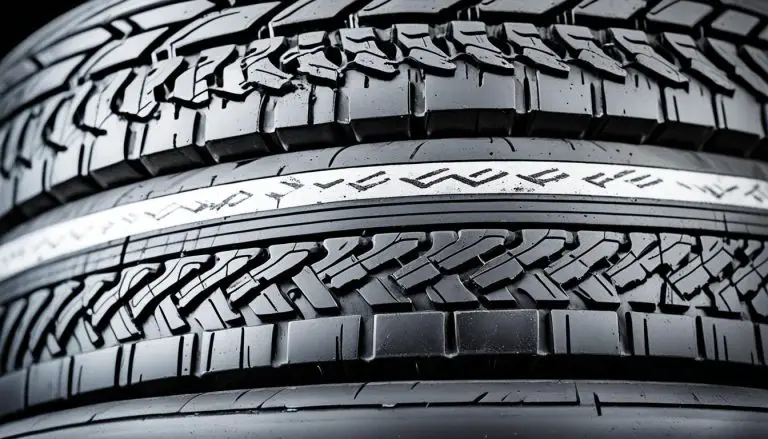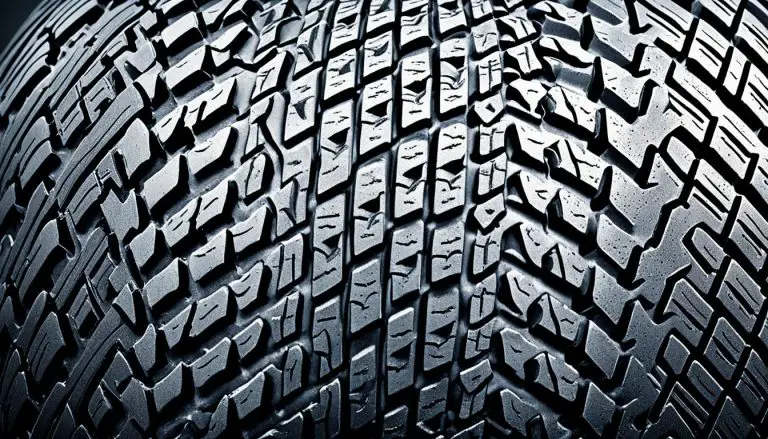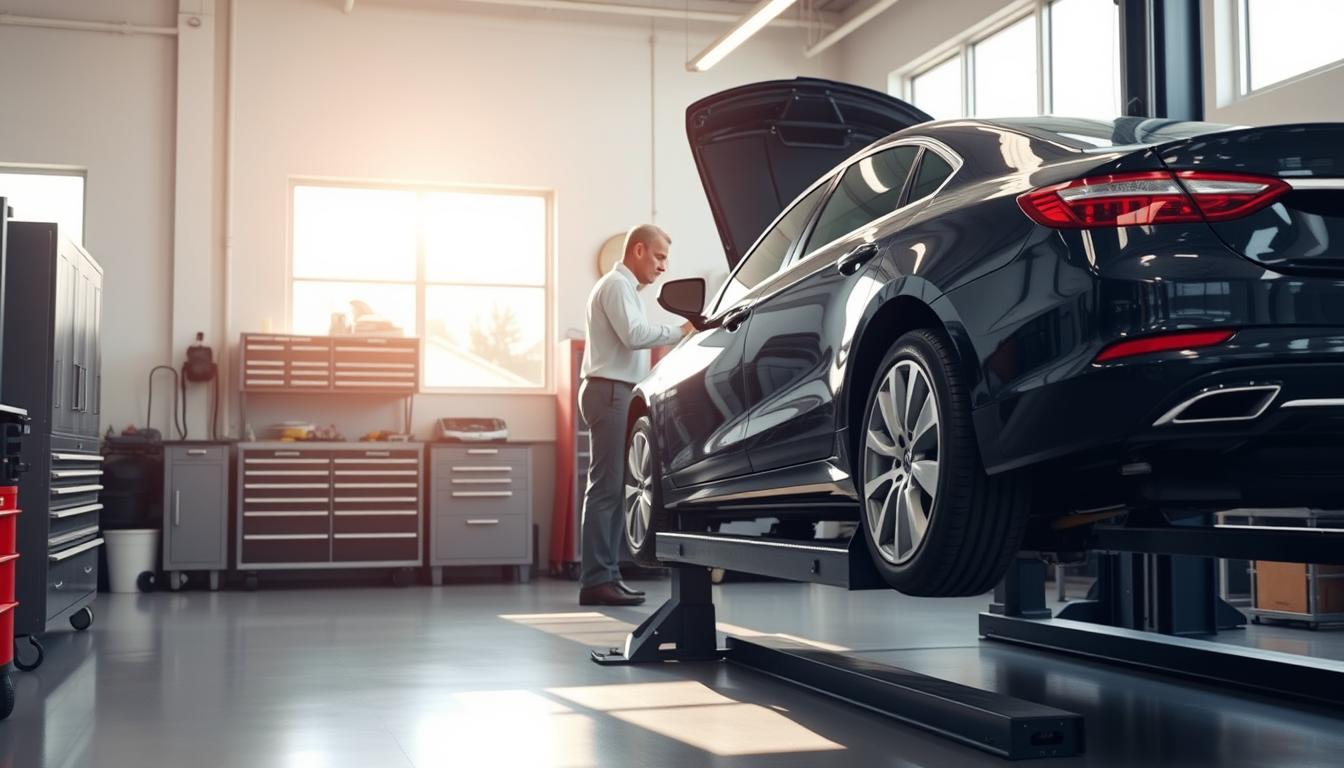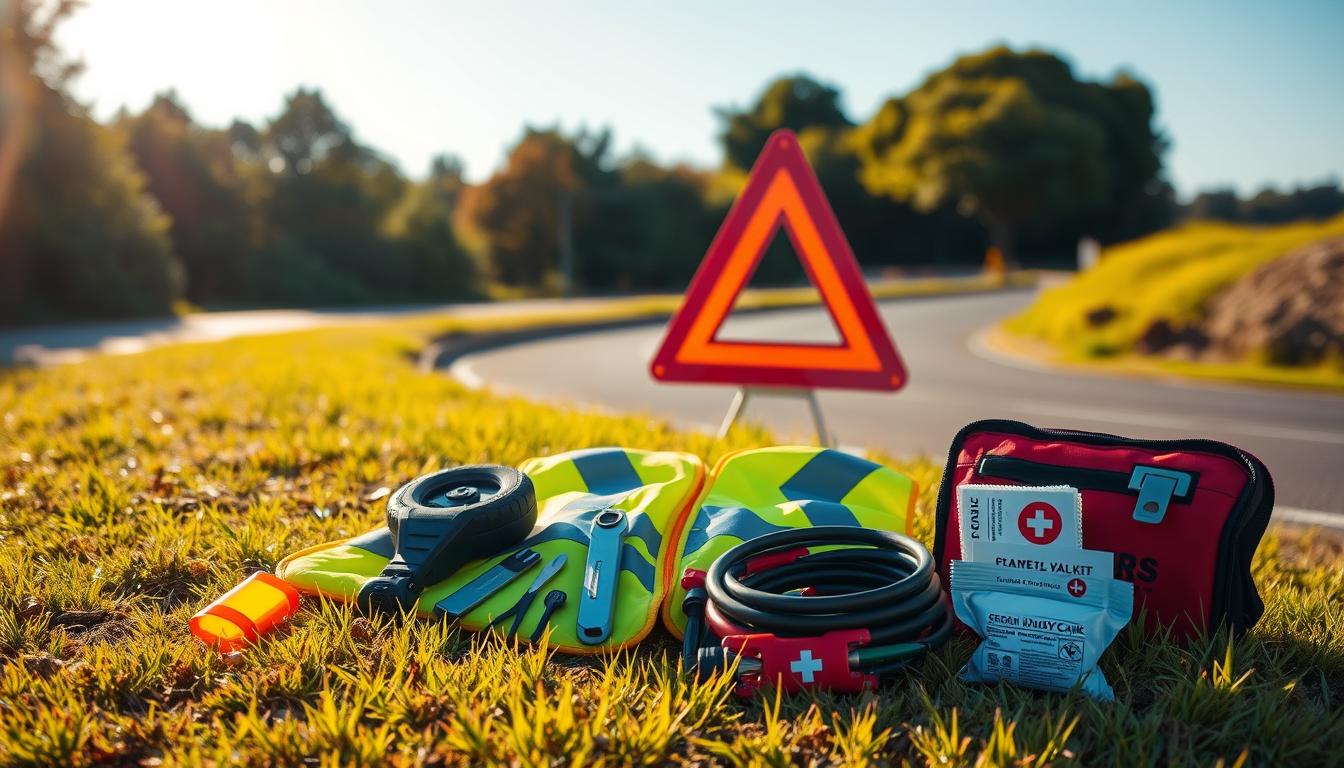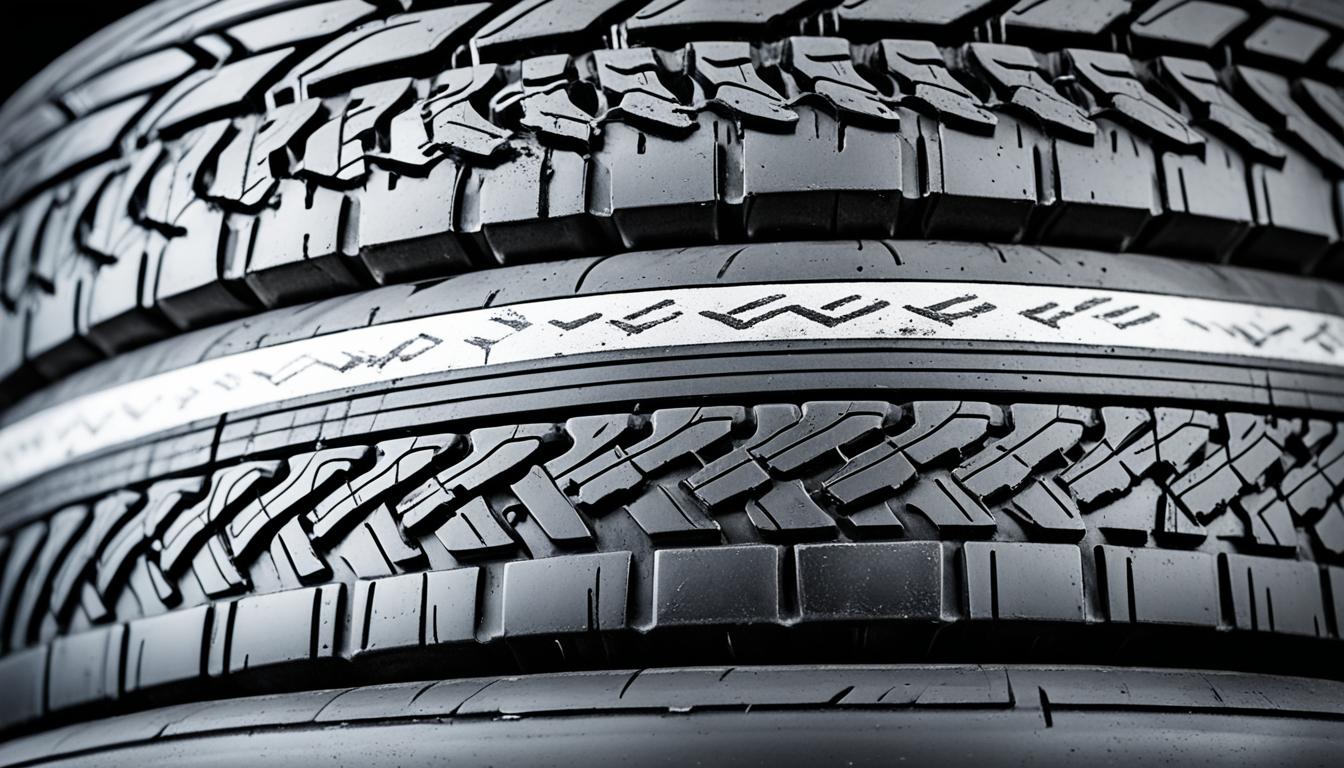
Did you know that badly kept tires can lower fuel efficiency by 10%? This shows how important tires are. They affect how your car runs, its safety, and how much gas it uses. Our guide looks at different tire wear signs. This helps you see why keeping your tires in good shape with regular checks is key. It includes things like aligning your wheels, rotating tires, and checking the pressure.
Tires wear out naturally. This happens because of things like not being aligned right or not enough air. When you see wear on the tire’s edges, it might mean your wheels are not aligned properly or your suspension parts are old. This can make tires wear unevenly, use more gas, and handle poorly. Knowing about these wear signs can help you stop them early. This can save you from having to repair or replace your tires too soon.
Getting your wheels aligned and checking your suspension keeps your tires from wearing out too early1. Making sure your tire pressure is right also matters. It can prevent types of wear like edge and feather wear. Feather wear is when one tire edge is smooth and the other is sharp, from bad wheel alignment. This guide is here to help you understand how to keep your tires, and your car, working well and safely.
Key Takeaways
- Poorly maintained tires can reduce fuel efficiency by up to 10%, highlighting their crucial role in vehicle performance and fuel economy.
- Shoulder/toe wear can indicate misalignment issues or worn suspension parts, leading to uneven tire wear and reduced handling1.
- Edge wear is often caused by under-inflation, resulting in excessive shoulder edge wear and decreased fuel efficiency1.
- Regular wheel alignments and suspension inspections are vital for preventing premature tire wear and maintaining optimal performance1.
- Properly maintaining tire pressure is essential to prevent wear patterns and prolong tire life1.
Understanding Tire Wear and Its Importance
Tires are crucial for road safety. They give us the grip needed to move and stop safely. By keeping our tires in good shape, we boost how our cars handle and perform. Now, let’s find out why tire wear matters and what it means.
The Role of Tires in Road Safety
Well-kept tires are a must for safe travel. Tires with deep treads grip the road better, especially when it’s rainy or snowy. States often say tires should be replaced when the tread is 2/32 of an inch deep2. Tires have wear indicators to check this, making sure we know when to replace them2.
Impact of Tire Wear on Vehicle Performance
Bad tire wear can make our cars perform poorly. As tires wear out, they lose their grip, which can hurt how our vehicles handle. It’s wise to rotate tires every 5,000 miles to wear them evenly and last longer2. We should also check tire pressure every month to avoid uneven wear, which hurts our gas mileage and can be dangerous2.
Getting our tires checked by pros and aligned, like at Creamery Tire, can solve many wear issues. This keeps our cars running well and safe.
Common Types of Tire Wear Patterns
Knowing about tire wear can tell you a lot about your car’s health. It lets you know when your vehicle needs help. The right checks and fixes can make your car handle better and be safer.
Shoulder/Toe Wear
If your tires wear more on the inside or outside, it shows a problem with how the wheels are lined up. This can mess with your steering and suspension, not good for safety3. Making sure your wheels are straight can fix this.
Camber Wear
When tires wear unevenly from the inside or outside, it’s likely a camber issue. Misalignment can mess up how your tires wear. This is a sign that the tires aren’t hitting the road squarely.
Edge Wear
Wearing more on the edges can mean your tires are underinflated3. It’s not just bad for your tires but for your gas mileage too. Keeping the right air pressure in your tires can stop this.
Center Wear
Too much air in your tires can wear out the middle3. This can mess with how your car grips the road. It also makes your tires wear out fast. Keeping an eye on tire pressure is key.
Feather Wear
Feathering wear means your tires may not be aligned right. One side of the tread is higher. Wrong toe alignment is usually the cause. Fixing this stops your car from making more noise and handling poorly.
Patch Wear
If your tires wear in patches, they need to be moved around. This keeps wear even and makes the tires last longer. It also helps your car stay steady on the road3.
Cupping Wear
Small dips or cups in your tires can mean a problem with the suspension3. Worn or twisted parts could be the issue. Acting fast keeps your rides smooth and your tires in good shape.
Factors Contributing to Uneven Tire Wear
Knowing why tires wear unevenly is key to keeping them healthy and your vehicle safe. There are several reasons for this problem. It can be due to misalignment, wrong tire pressure, or issues with the suspension.
Misalignment
Wheel alignment is vital for good tire contact with the road. Misalignment can make tires wear abnormally because it messes up the tire’s angle and direction. This means tires won’t wear evenly, hurting their lifespan. It can even mess with how well your car drives.
If your wheels or tires are not balanced right, they make tires wear unevenly. This leads to shakes in the car and odd wear patterns on the tire4. Also, hitting potholes can bend or damage wheels, making tires wear oddly from vibrations while driving4.
Improper Inflation
Getting your tire pressure right helps avoid strange tire wear. Too much air in the tire wears the center of the tread fast. Too little air wears out the tire’s edges4. The National Highway Traffic Safety Administration says check your tire pressure often. This helps keep your ride safe and smooth5.
If tire pressure goes unchecked, it can cause more than just uneven wear. It might mean your car needs an alignment check or has suspension trouble5.
Suspension Issues
Problems with suspension parts like ball joints and tie rod ends can lead to odd tire wear. For example, if you see your tire tread look scooped out, it could be due to bad shocks or struts4. This type of tire wear really messes with tire performance and how long they last.
Keeping up with suspension checks and fixes is important. Regular checks and quick repairs help keep the suspension system working well. That means better tire wear for you.
The Importance of Regular Tire Maintenance
Keeping your tires in top shape is crucial for a safe and smooth ride. This means checking tire pressure, getting wheel alignments, rotating tires, and inspecting the suspension. Doing these things keeps wear even, boosts how well your car drives, and makes sure you’re safe.
Tire Pressure Monitoring
Checking your tire pressure regularly is key. The car industry says you should check it once a month to avoid problems6. Tires that are too soft on air wear out on the edges more, and those with too much air wear out in the middle. Both can lead to tire bursts7. The right pressure helps tires grip the road better, makes your car stable, and lets it turn and stop well.
Wheel Alignments
Making sure your wheels are aligned is important. If they’re not, tires wear unevenly and don’t last as long7. A good alignment means your tires live longer and you drive safer. It’s wise to get an alignment if your tires wear weirdly or after a hard hit.
Tire Rotations
Changing where each tire sits on your car every 5,000 to 8,000 miles can make them last longer67. Doing this keeps the treads even, making the ride smoother and the tires less likely to damage suddenly.
Suspension Inspections
Checking your suspension system often is also a must. Bad suspension can cause tires to wear out oddly7. Fixing suspension problems quickly means your tires grip the road well. This improves safety and how comfortable the drive is. Together with good tire care, it cuts the chance of tire issues.
| Maintenance Practice | Frequency | Benefits |
|---|---|---|
| Monitor Tire Pressure | Monthly | Improves fuel efficiency, prevents blowouts67 |
| Wheel Alignments | As Needed | Prevents uneven wear, extends tire life7 |
| Rotate Tires | Every 5,000 – 8,000 miles | Balances tread wear, enhances performance67 |
| Suspension Inspections | Regularly | Ensures proper tire contact, improves safety7 |
How to Inspect Your Tires for Wear
Checking your tires regularly is key to keeping them in good shape. By learning how to inspect them, you can catch signs of wear early. This helps extend the life of your tires.
Visual Inspection Tips
Start by looking at your tires closely. Watch out for tires that wear out unevenly, have cracks, or bulges. These could mean your tire pressure, alignment, or suspension needs checking. If you see odd patterns on the tire, it might be over or underinflated8.
Using the Penny Test
The penny test is a quick way to see if your tires need changing. Put a penny in the tire tread. If you can see the top of Lincoln’s head, your tires are too worn. In many places, this means the tread is less than 2/32 of an inch9108. New tires usually have more tread, about 10/32” to 11/32”10. Doing this test helps keep you safe by telling you when to get new tires.
Understanding Tire Tread Depth and Safety
It’s crucial to ensure your tires are at the right legal tread limit. This matters a lot for staying safe on the road and making your car perform well. Typically, new tires have a tread depth between 10/32″ to 11/32″11.
Minimum Tread Depth Requirements
In the U.S., the legal tread limit for passenger vehicles is 2/32 of an inch12. Studies show that cars with treads under 2/32″ are three times more likely to have tire problems before a crash11. This makes it vital to often check your tire treads to maintain good traction and ensure they’re okay12.
The Penny Test for Tread Depth
Try the Penny Test to check your tread depth. Put a penny into the groove with Lincoln’s head facing you. If Lincoln’s head is fully seen, your tires are below the legal tread limit and need changing13. Remember, tire wear can be uneven, so check different spots around the tire13.
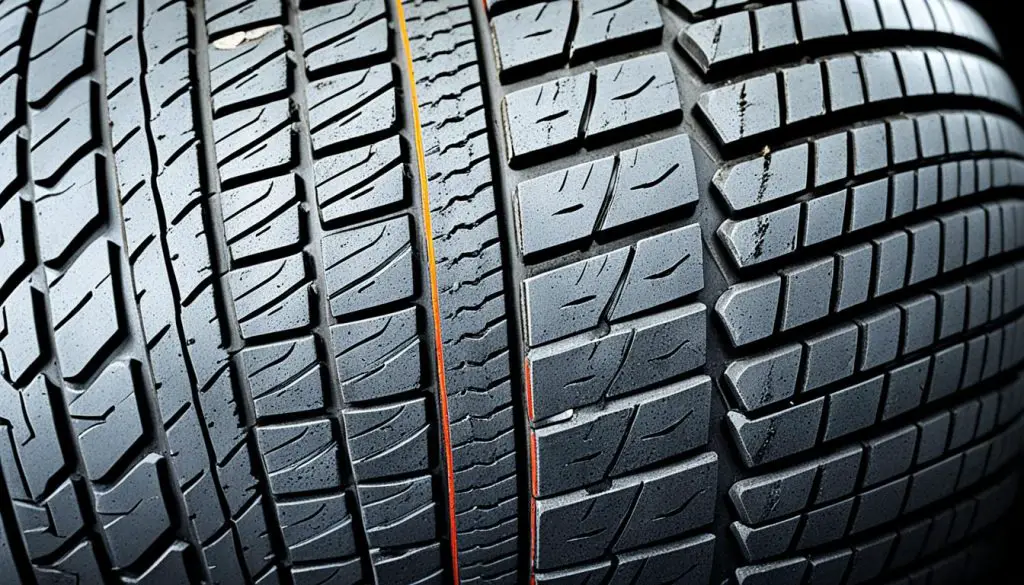
Another way to check is by looking at the tire tread wear bars. When the tread reaches these bars’ level, it’s a sign your tires are too worn out to be safe12. Good tread depth safety boosts your car’s grip, reduces stopping time, and helps on slippery roads. Consumer Reports says tires at 5/32″ or less risk hydroplaning, take longer to stop in the rain, and struggle with snow traction11.
Benefits of Proper Tire Inflation
Having the right amount of air in your tires is key. It helps your car use less gas, makes tires last longer, and keeps you safer on the road. When tires don’t have enough air, your car has to work harder. This uses up more gas, lowering your mileage by 1% or more14. Keeping your tires just right means you’ll use less fuel.
Enhanced Fuel Efficiency
Using the right tire pressure saves gas. Tires that are too soft make your car use more fuel. They slow your car down because of something called ‘rolling resistance’. This means your engine has to work harder15. By checking your tire pressure often, you can use gas more efficiently.
Extended Tire Life
Good tire pressure also means longer-lasting tires. If your tires are 10% low on air, they heat up more. This can damage them inside and cut their life by 30%. Tires that are too full wear out unevenly, reducing their life14. Keeping the right amount of air in your tires helps them last longer. This saves you money and makes your car safer.
Improved Handling and Safety
Having properly inflated tires is vital for safety. Tires that are too soft often cause accidents. They are the main reason for tire problems, like blowouts, in 95% of cases14. Check your tire pressure at least once a month to stay safe15. Following your car’s tire pressure recommendation makes sure the tires work as they should. This gives you good grip on the road and helps you stop safely.
Tire Replacement: Knowing When It’s Time
It’s vital to replace your tires on time to keep driving safe. Tires wear out, so knowing when they need changing is key. This ensures your vehicle runs safely.
Indicators You Need New Tires
There are clear signs tire replacement indicators to watch for. Tire tread depth is important; in the U.S., it must at least be 2/32″ for safety16. A tread less than 1/16th inch means you need new tires17. After 10 years, old tires are risky and should be changed, no matter their wear16.
Also, look for cracks on the sidewalls from aging or sun exposure, as these need replacing17. Keeping proper tire pressure is essential for safe driving on all roads17.
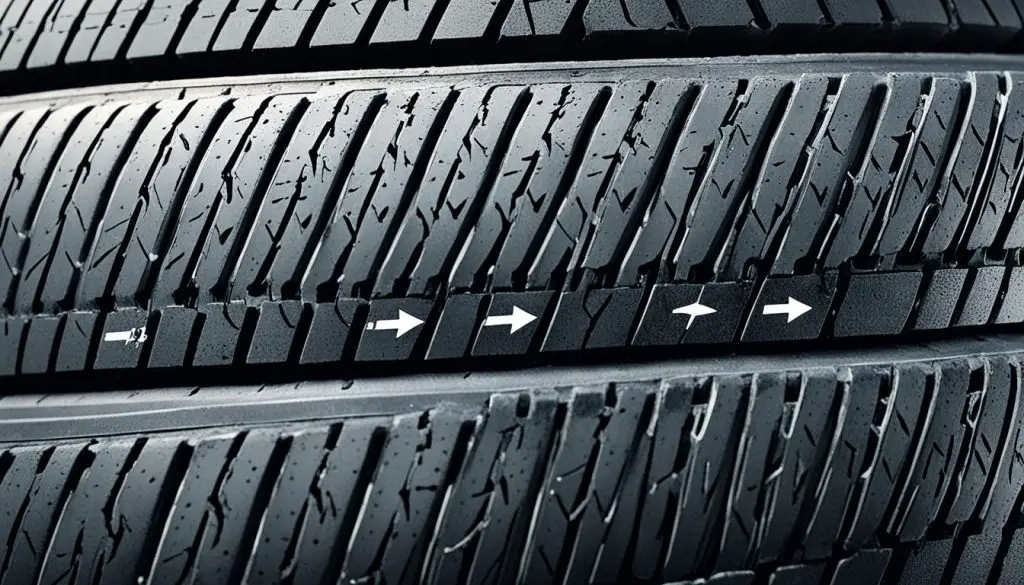
Choosing the Right Tires for Your Vehicle
Picking the proper vehicle-specific tires is crucial. Replacing all four tires together is best for your car’s overall performance16. If you can’t change all at once, try to match them closely for balance and safety16.
Bridgestone even replaces recalled tires for free to keep you safe16. When buying tires, consult your vehicle’s manual for the best choices. Safety and specifications should guide your decision.
Don’t forget about tire checks. Bridgestone suggests monthly pressure checks to maintain safety and tire life16. A professional should inspect all tires, including the spare, often to catch problems early16.
| Replacement Indicator | Recommendation |
|---|---|
| Tread Depth (2/32″) | Replace Tire |
| Cracks on Sidewall | Replace Tire |
| Age (10 Years) | Replace Tire |
| Improper Inflation | Regular Check |
Professional Services for Tire Maintenance
Keeping your tires in top shape helps your car stay safe and last longer. Skilled tire service checks your tires inside and out. It catches and solves problems before they become big issues.
Importance of Expert Inspections
Getting your tires looked at regularly is key for your car’s health and safety18. A professional checks your tires for certain wear signs. These include strange tire wear, vibration, and if your car tends to drift to one side while you drive18. These signs mean it’s time for a professional to take a look.
What to Expect During a Tire Service
At a tire service, your tires will undergo a detailed check and necessary work. This might involve rotating your tires every 5,000 to 8,000 miles1819. They also make sure your tire pressure is just right. Too little air can damage tires, while too much can wear them down in the middle18.
This check might also look for odd tire wear from driving hard, towing, or rough roads19. It’s crucial to know the right way to rotate and balance your tires. This varies for different types of tires, like sports or off-road tires, because of how they wear19.
Plus, experts also measure how much tread is left on your tires. When it’s less than 2/32 of an inch, or they’re clearly worn, or over six years old, it’s time for new ones18. When picking new tires, think about your car, how you drive, and where you drive18.
Conclusion
It’s crucial to know about tire wear and to keep your tires well maintained. Doing this will help your tires last longer and keep your vehicle in good shape. Checking your tires often can help you spot early signs of wear or alignment issues. This can save you money on big repairs and keep you safe while driving20. Watch out for signs like uneven tread wear, cupping, or bald spots. They might mean there are alignment problems or that the tire pressure is off20.
Rotating your tires makes sure they wear out evenly, which can make them last longer20. How often and in what way you should rotate your tires depends on your vehicle’s setup and the kind of tires you have. Safety first, by taking care of your tires, you also improve your vehicle’s performance. This is especially important when the weather is bad20.
Buying good tires and taking smart care of them really helps. If your tires are old or damaged, you could be in more danger of getting into an accident. This makes replacing your tires on time very important20. You can learn more about checking tire wear and how to rotate tires in this comprehensive guide. Follow these steps, and your vehicle will stay in top shape, giving you peace of mind while driving.
FAQ
What are the common causes of uneven tire wear?
Uneven tire wear happens due to various reasons. This includes misalignment and wrong tire inflation. Suspension issues also play a part. Misalignment affects tire contact with the road, leading to uneven wear. Wrong inflation can cause edge or center wear. Suspensions problems might cause cupping.
How often should I check my tire pressure?
It’s best to check your tire pressure once a month. Before long trips is a must. Doing this makes sure your tires work well. It also helps your car use fuel better and last longer.
What are some signs that I need a tire rotation?
If your tires wear unevenly, it’s a sign they need rotating. You’ll also notice different tire wear patterns. Getting your tires rotated regularly makes them last longer and work better.
How can I tell if my tires are misaligned?
Misaligned tires show signs like uneven wear. You might feel your car pulling to one side. A crooked steering wheel on a straight road is another sign. If you notice any of these, check your wheel alignment.
What is the penny test, and how do I use it to check my tire tread?
The penny test is an easy way to check your tire’s tread depth. Put a penny in the groove upside down. If Lincoln’s head is visible, it’s time to change that tire. It means the tread is too low for safety.
Why is proper tire inflation important?
Right tire inflation does a lot for your car. It makes fuel use better and keeps you safe. Low pressure wears tires out fast and can make them overheat. Too much pressure means less grip and a bumpy ride.
When do I need to consider tire replacement?
Think about getting new tires when the tread is too low. If they wear out unevenly or badly, it’s time. Look for wear indicators on the tires to help decide. Damage that can’t be fixed is another reason to replace them.
What benefits do regular tire maintenance practices offer?
Regular tire care helps your tires last longer and work well. Checking pressure, aligning wheels, rotating tires, and looking at suspensions all matter. This can stop tires from wearing out too soon and keep your car handling right.
How does tire wear affect vehicle performance?
Tire wear makes your car’s road grip worse and stops it slowly. It also messes with how the car feels and uses fuel. Keeping regular track of tire wear and taking care of them is key to avoid these problems.
What should I expect during a professional tire service appointment?
At the tire shop, expect them to check a lot of things. They’ll look at the tread, pressure, and how the tires wear. Checking the alignment and looking for suspension troubles is part of it. They might even balance the tires. And they’ll advise on what’s needed to keep your tires in good shape and safe.
Source Links
- https://www.rivercityford.ca/tire-wear-and-what-it-means-a-comprehensive-guide/
- https://creamerytire.com/blog/tire-wear-petterns-you-should-know-about/
- https://www.firestonecompleteautocare.com/blog/tires/how-to-read-tire-wear-patterns/
- https://www.monroe.com/technical-resources/shocks-101/why-do-tires-wear-unevenly.html
- https://www.allstate.com/resources/car-insurance/tire-wear-patterns
- https://jacksautorepair.com/importance-of-tire-maintenance/
- https://stearnscompanies.com/eds/blog/the-importance-of-proper-tire-maintenance-for-truck-safety-and-performance/
- https://www.valleynissan.com/blogs/1382/how-to-check-tire-tread-depth-at-home/
- https://www.bridgestoneamericas.com/en/company/safety/maintaining-tires/tire-inspection
- https://www.bridgestonetire.com/learn/maintenance/how-to-check-your-tire-tread-penny-test/
- https://www.travelers.com/resources/auto/safe-driving/how-to-check-tire-tread
- https://jacosuperiorproducts.com/blogs/news/the-simple-guide-to-checking-your-tire-tread-depth-and-knowing-when-to-replace-your-tires
- https://bigchieftire.com/blog/tire-tread-depth-chart-your-quick-reference-guide/
- https://www.imiproducts.com/blog/proper-tire-inflation/
- https://www.bridgestoneamericas.com/en/company/safety/maintaining-tires/tire-inflation
- https://www.bridgestoneamericas.com/en/company/safety/choosing-tires/replacement-guidance
- https://www.piazzasubaru.com/tire-warning-signs—3-indicators-it-s-time-to-replace-them.htm
- https://thetirestore.com/auto-repair/tire-services/
- https://www.mydriversedge.com/tire-rotation-balance-keep-wheels-top-shape/
- https://www.mevotech.com/article/the-importance-of-tire-wear-inspection-and-rotation/
